With adept skill in transforming two-dimensional space into compelling commentary, Tom Torluemke creates layered narratives that are informed by his upbringing, a coterie of symbolic imagery, and our contemporary social and political milieu. This week the COMP Magazine trekked down to Dyer, Indiana, to talk with Torluemke about his youth in Chicago in the 1960s-70s, running an art gallery in Hammond, Indiana, his book “Symptoms”, and his evolving aesthetic practice.
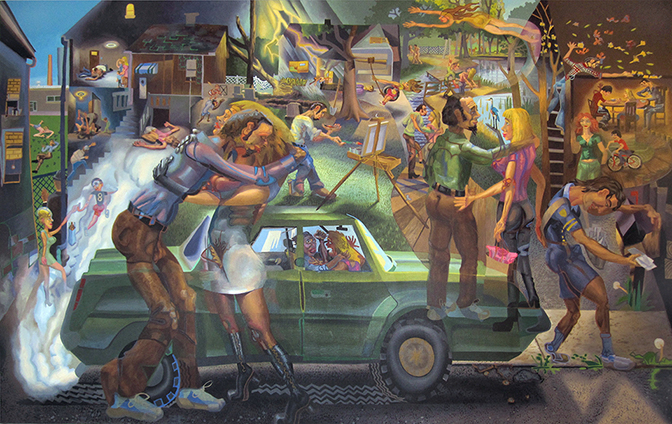
Tom Torluemke, Ring Around the Rosie, 2011 , acrylic on canvas , 76 x 116 5/8″
You now live and work in Dyer, Indiana. However, you were born and raised in Chicago’s Humboldt Park. I’d like to step back a bit. From what I’ve encountered, this working class neighborhood was not a center of aesthetic investigations in the 1960s. Do you recall what prompted you to explore new paths and devote yourself to making art?
Yes, I do remember…. I grew up in Chicago’s near north neighborhoods. When I was born, we lived near Fullerton and Ashland. When I was around 13, I became friends with a kid named Joe, we had similar interests in art and music. He lived in Humboldt Park and we spent our time going back and forth to each other’s houses, we were inseparable. Several years later we moved in together in an apartment attached to a Church on the Boulevard, we were custodians in exchange for rent, we lived together for a few years.
During my formative years, the people I knew, the experiences I had and the conditions under which I lived made a profound searing mark on me. My Father grew up in Cabrini, he had a very difficult life. He was sad, struggled with demons, often giving in to vice and violence. He drove a cab, bartended and was a magician who was frequently chased by the mob.
My Mother was a tireless worker, sometimes with three jobs; waitress, factory worker and caterer. She had a hobby of entering art coloring contests, like the ones that were often advertised in the 60s on the back of cereal boxes. She was quite good at it. There was hardly a month that went by without a deliveryman bringing us a big box with a prize inside and usually it would be something for me like a bike or even a vacation. Anyway, that taught me if you work hard on an art project you might win an award.
This brings me to the bigger picture. Since my Ma worked so much, I spent a lot of time with my grandparents and great uncle. We lived in a 3-flat and there was also a rear house. The main house was filled with family, my Grandparents and Great Uncle Freddy on the top, cousins on the main floor, us in the garden apartment and Great Aunt Rose in the back.
They were quite a cast of characters.
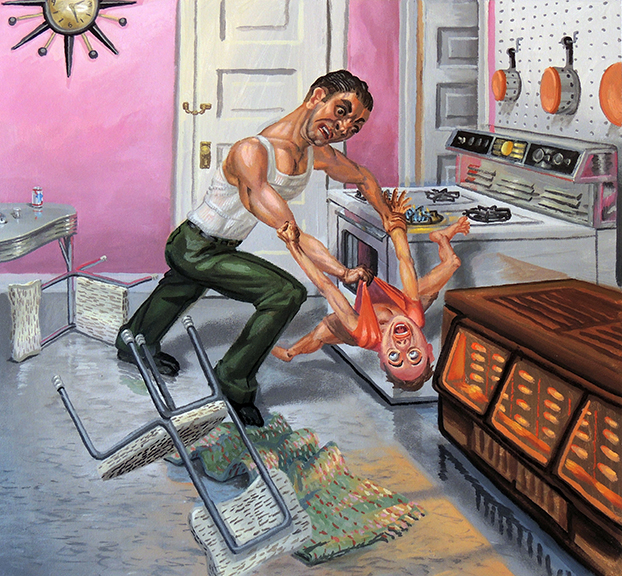
Tom Torluemke, Hand To The Fire, 2013 , acrylic on canvas , 36 x 36”
My Grandmother, Lou Lou was very sweet, she spoke German and English; she cooked and cleaned all day. She was agoraphobic, so when the newspaper was delivered, she would have to bring a broom to the front door, open it ever so slowly, only a crack wide enough so she could fit the broom stick through and keep taking blind swipes at the porch until she found the paper and could drag it to the opening.
My Grandfather was a very large, tall (6’ 5 or 6”), very thick and broad. He had giant hands that could wrap around my head as if it were a baseball. He was a German farmer from the Pennsylvania Dutch area. During the Depression he burned down his farm, he got caught and went to prison. After prison he made his way to Chicago and got a job at International Harvester working on a punch press. One day, there was a mishap, a 400lb weight fell on his head and crushed his skull. He was never the same, a little off, a little simple, overly nice, polite and congenial. He was always dressed sharp with a big wide brimmed hat. In the summer he wore a straw hat and walked the neighborhood, always tipping his hat “good afternoon” to the ladies. He was very pressed and clean but could not control his faculties, when he was out, he would often wet himself.
My Great Aunt Rose from the back house lost her husband in the Great War and was never the same. She was funny, loved to laugh, had red hair and wore red lipstick. She was very smart, sharp as a tack. She walked the streets and rarely came home. She hung out in coffee shops and McDonalds, read the news and talked to the regulars. She was a bag lady, not homeless, she just never got over her loss. Every so often the family would do an intervention to clean her up against her will. So she could start all over again, all to be cleaned up again the following year.
Now finally we come to my Great Uncle Freddy. He was deaf and mute and could not sign or read lips. He watched me often when I was growing up and in order for us to communicate, we would draw pictures back and forth to each other. He could draw very well. So I learned at a young age how to communicate with images.
My other Grandmother was actually my Dad’s Stepmother, she lived in Uptown and going to visit was visiting the darker side of the family. She surrounded herself with, gamblers, cat burglars, prostitutes and drug dealers. I witnessed one of the their friend’s have an epileptic seizure on several occasions. They lived in a third floor apartment at the corner of Leland and Broadway. There was a tavern on the ground level, the kind of place where people would get stabbed. Just south of the entrance to the tavern was an alley that connected to Wilson where there was a bar called The Wooden Nickel, it was a bar where the Native Americans in the area went. The alley was called “Blood Alley” and many times while walking, I saw the sad devastation of the Native American community, ruined by us through alcohol.
When I was about ten years old, I worked across the street on Broadway at a woman’s clothing store called Yorks. I watched for shoplifters, then snitched on them. We used to get lunch from a pizza place that got shut down for using dog and cat meat.
Then I’d go home into my house and my Dad would have my Mom in a long coffin like box, sawing her in half and I would start screaming No! No! No! My Dad would say, “Don’t worry, it’s OK, I’m just practicing some magic.”
These experiences trained me in the important art of empathy. Without empathy there is no imagination and there is no empathy without imagination.
We’re all human, we’re all capable of good and bad; we have good luck, we have bad luck. Some people can pull themselves up by their bootstraps, others can’t.
We all love, feel pain, try to laugh and have fun, eat or try to eat, some fall prey to vice, others to pride or prejudice. Sometimes we are weak other times we’re strong. We can be healthy or sick. We don’t always make the right choices but we must try.
Those people loved me, all of them. They were so happy and eager to take a careful look at what I drew for them.
That’s what prompted me to devote myself to making art.
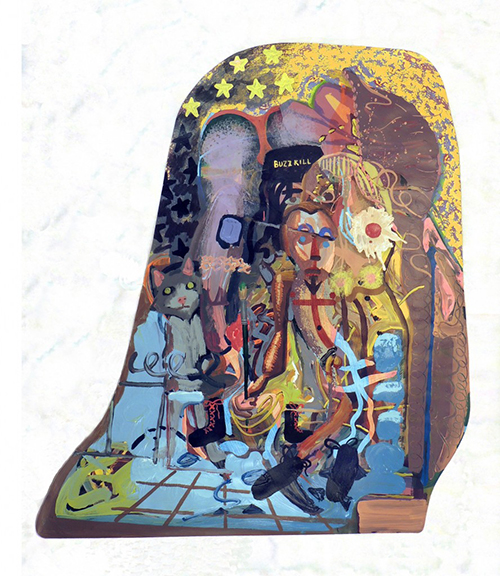
Tom Torluemke, Family Portrait, 2015
,
irregular shaped painting acrylic on paper on MDF
, 60 x 51 1/2″
You’ve made work in seemingly polar environments, Chicago’s urban scene and Dyer’s somewhat rural atmosphere. Having done so, have you noticed any differences in how you think about and create paintings?
It’s always been about people their relations to each other and or their relations to their surroundings, home, neighborhood, state, country and world. It’s exactly the same for me and my art. In the city I had a city background, a whole lot of buildings small and large, parks, humans and small amount of green space.
In Dyer it’s the reverse, same ingredients, just different proportions. There is more green space, smaller buildings, less humans, less variety of humans. Less experiences equals less understanding. The less variety of human experience is replaced by more variety of nature.
So the core ideas of my paintings remain the same, the names change and the backgrounds change.
But I do have to fight the continuous urge to go out and paint landscapes.
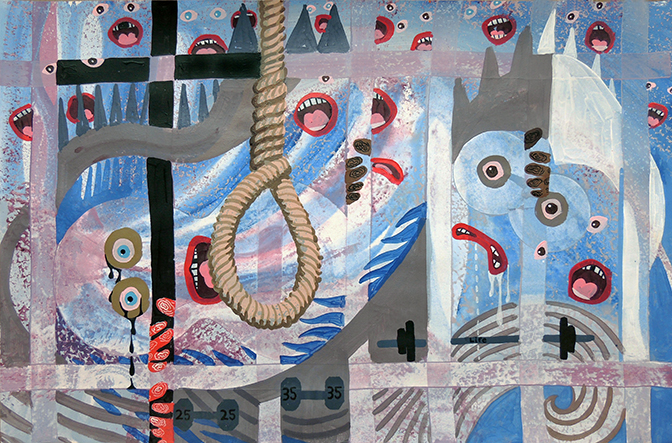
Tom Torluemke, Flooded Prison, 2014 , acrylic on paper on MDF, 26 x 39 3/4″
In addition to working as an artist, you and your partner, Linda Dorman, ran Uncle Freddy’s art space for a sustained period of time. During the gallery’s tenure you were noted to show a fairly diverse roster (e.g., Jno Cook, Gordon Ligocki, Ish Muhammad). In addition to supporting artists, what did you find most rewarding or challenging in this effort?
It was wonderful working with the artists, we didn’t follow trends and showed quite a variety of work from Chinese Peasant Paintings, Original World War II Comics, Conceptual Philosophy Work by Adelheid Mers to Graffiti art. We were even invited by Art Chicago to be a part of the International Invitational in 2004. Our booth was right next to a gallery from Berlin, figure that. They were exciting times, the challenge was getting people out to Hammond and closing the deals.
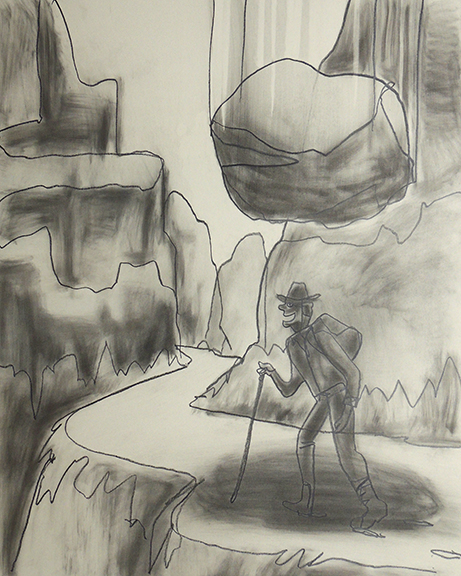
Tom Torluemke, Wow! Nature Is So Beautiful And Powerful!
I Wish I Could Do This Every
Day!, 2014,
graphite and charcoal on board
, 40 x 32″
I’m very interested in the series, Blind Man’s Bluff. Can you walk us through your process in developing a series of work? Perhaps, you can identify what piques your interest and how you address conceptual and formal frameworks in addressing a specific topic.
The title of that series is based on my feelings when creating art, it’s as though I’m always blindfolded with my hands stretched out trying to find something and I rarely do and if I do it’s never what I expected.
Anxiety is the word, it has to be an artist’s best friend or else you will quit.
If you’re trying to make work that’s universal, eternal as opposed to temporal you have to embrace the unknown and mysterious. So that title, (Blind Man’s Bluff) it’s a symbolic meaning, about my day to day art making philosophy. I go wherever my spirit takes me with the hope I get some decent stuff, things I haven’t seen before.
It also led me to a more literal approach. I did a blog called Eye’s Wide Shut, where I posted several satirical drawings a week, based on things we crazy people do. The drawings were created with my eyes closed, then shaded with my eyes open.
I’ve been drawing with my eyes closed for about 20 years, but I just recently started showing them or incorporating them into my other work. Like drawing my paintings out with my eyes closed before I paint them. Anyway, I hope that sheds a little light on that series.
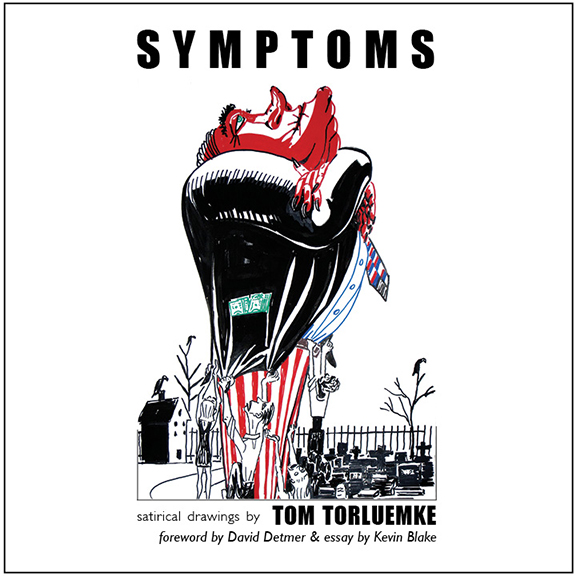
Tom Torluemke, forward by David Detmer, and an essay by Kevin Blake, SYMPTOMS, Book Cover, 2016
You book Symptoms (2016) is a collection of satirical drawings with an essay by artist Kevin Blake and an introduction by author David Detmer. There is a socio-political voice couple with a simplified color palette. Upon first glance, I saw these works as linotype or woodcut prints. Can you share with us your intent with this work?
I was so lucky to be able to have those two writers for the book, they really lift the book to a whole new level; they make my work look good. They’re colored drawings done on paper, done with acrylic paint marker. At first I was going to use only red, white and blue because they are political American satirical cartoons. I did one every day for nearly a year in 2011. I started adding a few more colors to make it fuller and more fun for me. It was 50/50 half current events and half general misbehaviors. I stopped when I realized every three months or so, history starts to repeat itself. Whenever I heard that phrase, I thought if I wanted to know what was going to happen in the future, I could look back maybe 100 years, but no, we make the same mistakes a couple months later. So at about a year, I was done.
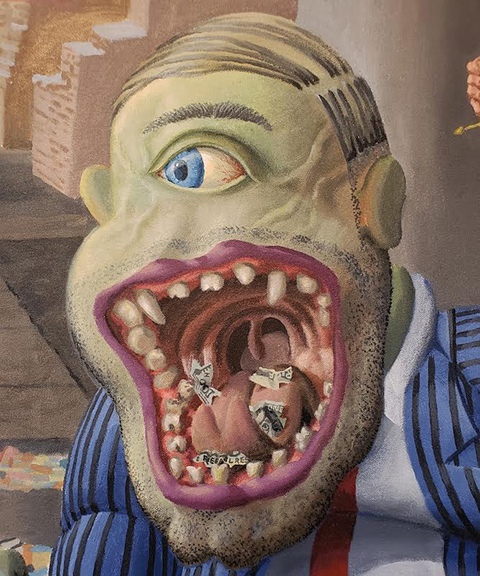
Tom Torluemke, (DETAIL) Working Title: Be Careful (Don’t Get Struck By Myopia), 2018,
acrylic on canvas
What do you find most rewarding in your aesthetic practice?
I feel privileged to spend my life with art, it’s kept me curious, like a child. I look forward to waking up eager to learn something new, see something different, think about something I haven’t thought about before. That’s my reward.
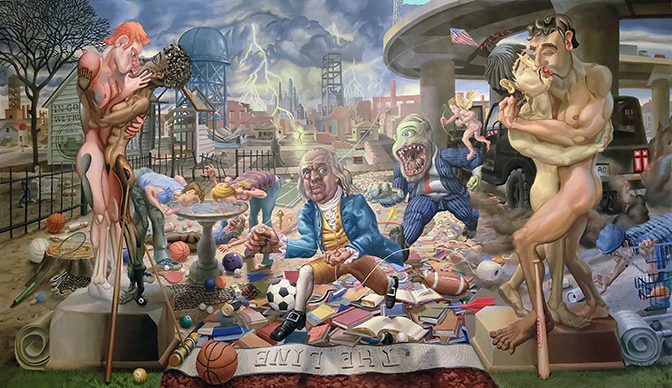
Tom Torluemke, Working Title: Be Careful (Don’t Get Struck By Myopia), 2018 , acrylic on canvas , 76 3/4 x 128 3/4″
When I visited, you were working on a rather large painting. I am curious what your current focus is for the remainder of 2018. Do you have any upcoming exhibitions or other items you can share?
The large painting you saw may be titled, “Be Careful (Don’t Get Struck By Myopia)”. It’s an allegory for our times. The Cyclops is chasing the Benjamin along a path of wordless books (All the books of time surely have the answers, we need to behave and survive. It’s as thought the books never had words.)
All the sport and game items have been abandoned, because there’s no time left for games. Those are just a few of the many symbols to be unraveled.
I’m working towards a major show in the future, look forward to the announcement.
In the meantime, I am in a group show at Ari’s Art Space, 4200 W. Diversey, and some of the Symptoms drawings will be in a group show at Co-Prosperity Sphere, 3219 S. Morgan St. in May. I’m having a solo show at Cultivator Art Farm on Memorial Day and I am working on a historical mural for the City of LaPorte, Indiana that I will paint this summer.
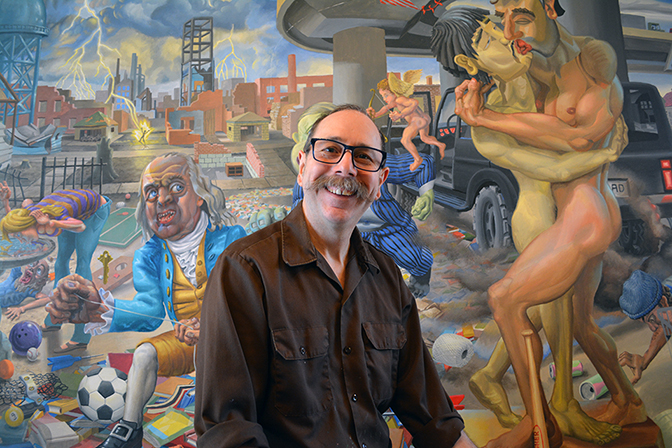
Tom Torluemke, artist, Dyer, Indiana, 2018 by Chester Alamo-Costello
For additional information on the work of Tom Torluemke, please visit:
Tom Torluemke – http://tomtorluemke.com/
Tom Torluemke Drawings – http://torluemkeblinddrawings.blogspot.com/
Tom Torluemke Blog – http://tomtorluemke.blogspot.com/
Linda Warren Projects – http://lindawarrenprojects.com/artists/tom-torluemke/
Tom Torluemke at TEDxPurdueU – https://www.youtube.com/watch?v=FcCV1m6h19A
Art Slant – https://www.artslant.com/global/artists/show/175325-tom-torluemke?tab=PROFILE
Artist interview by Chester Alamo-Costello


